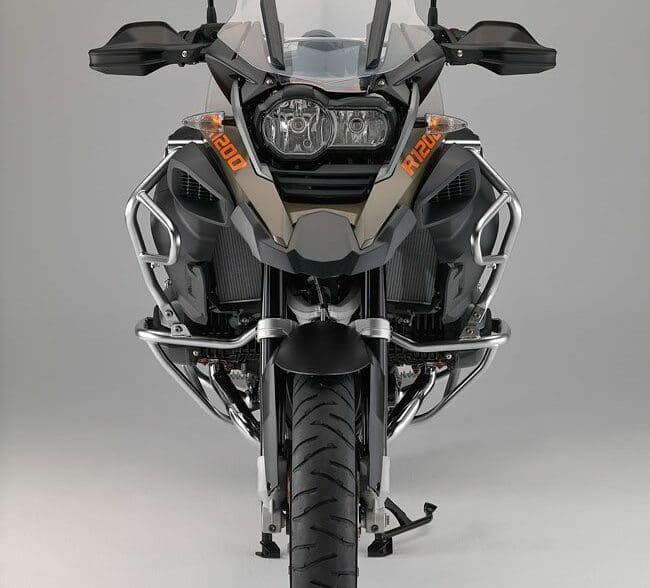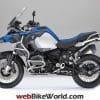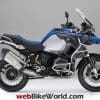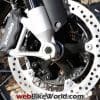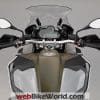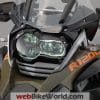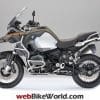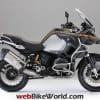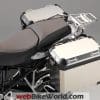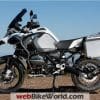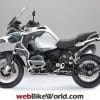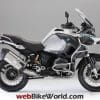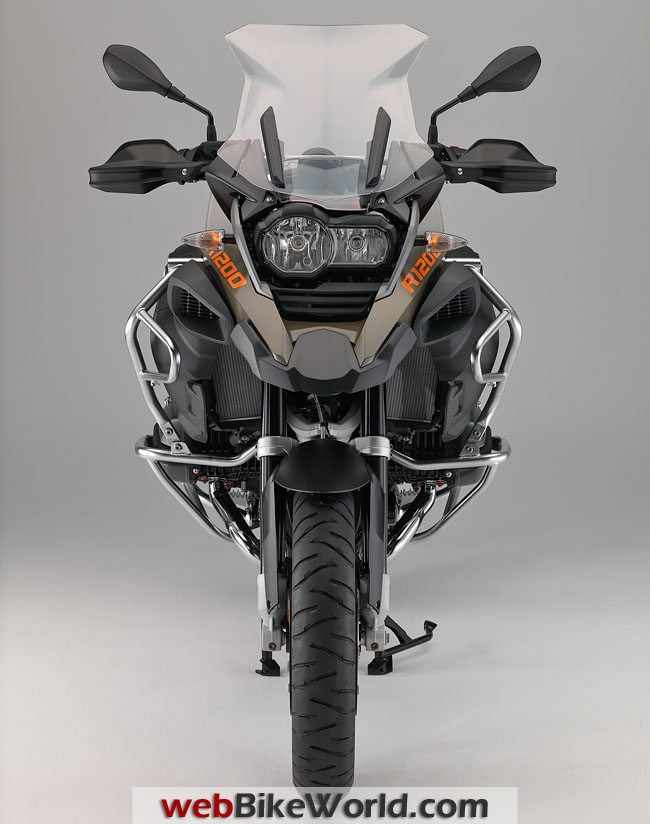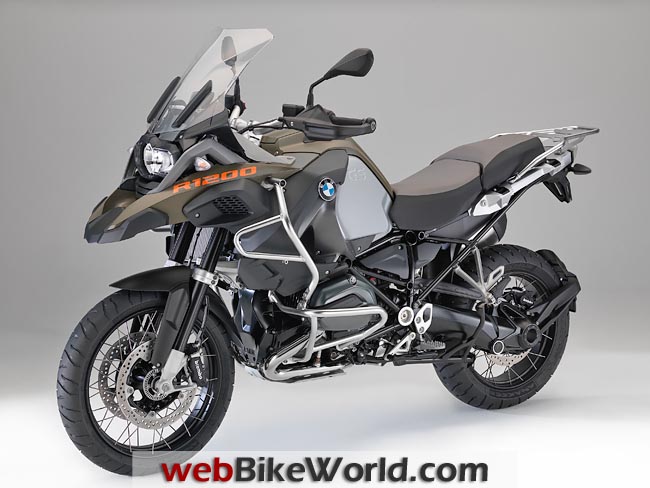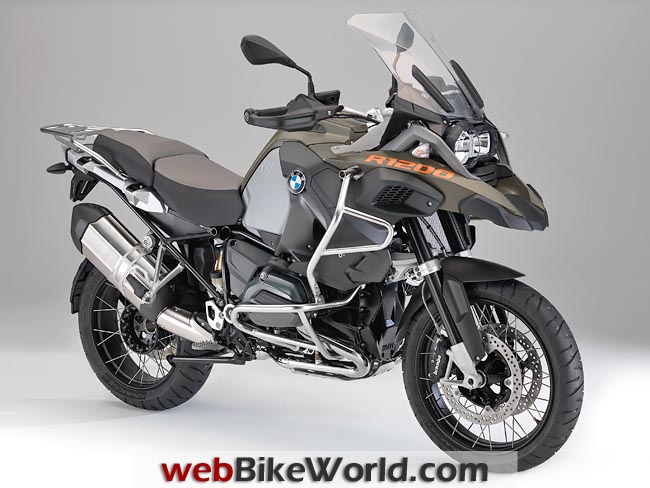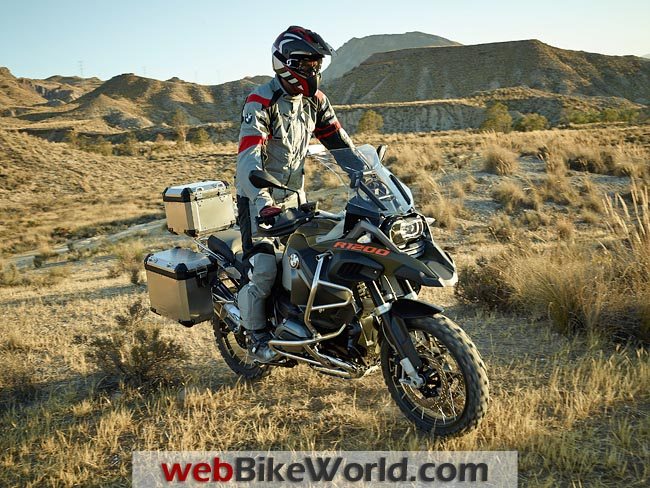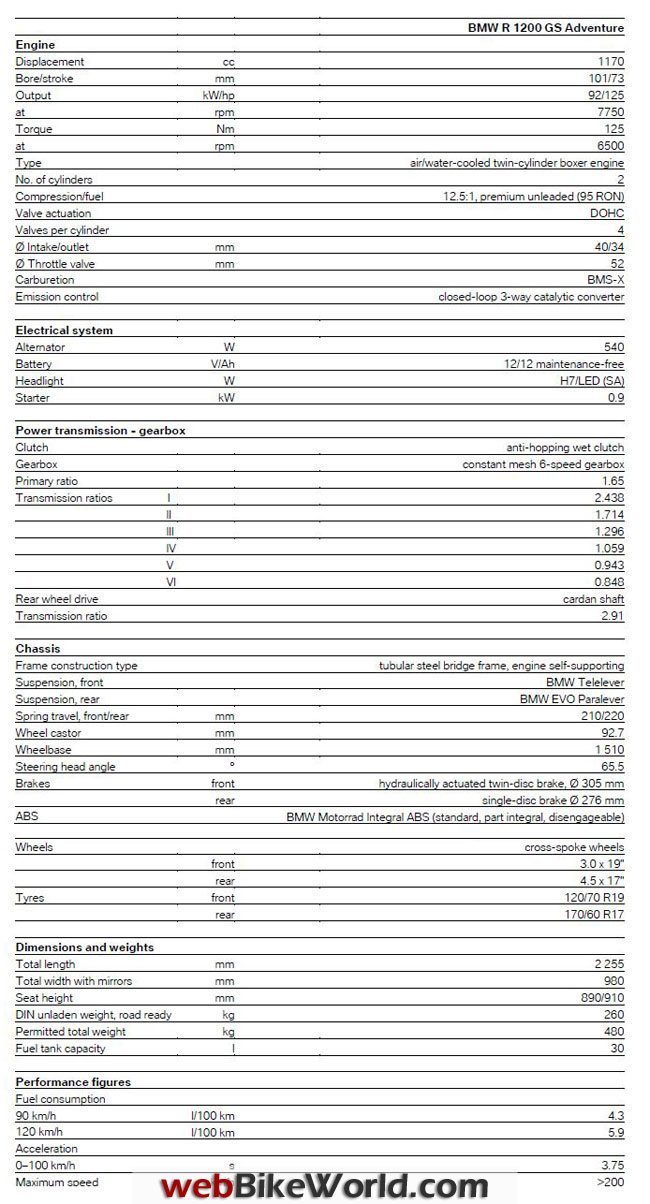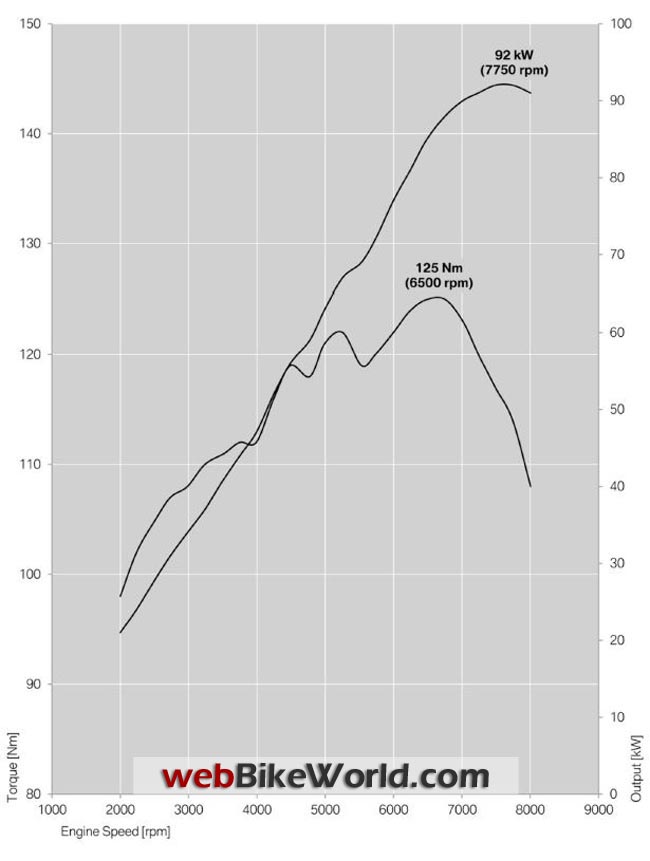October 7, 2013 – It was 1 year and 5 days ago when BMW announced the new R 1200 GS with its new water-cooled engine.
Today BMW Motorrad has announced the R 1200 GS Adventure version of the “Water Boxer”.
The 2014 BMW R 1200 GS Adventure includes Increased flywheel mass in the engine and additional vibration damper “for even smoother running and superior rideability”, according to BMW.
Spring travel has been increased by 20 millimeters at the front and rear compared to the R 1200 GS, while ground clearance has been increased by 10 millimeters.
The geometry of the trailing arm has been modified to improve handling and restyled bodywork also differentiates the GS Adventure.
A 30 liter fuel tank, ABS, ASC and two riding modes are standard; additional riding modes are available as a factory option.
The Dynamic ESA (Electronic Suspension Adjustment), a semi-active suspension, is available also as a factory option.
The seat has been made more comfortable with a tilt adjustment and adjustable, reinforced brake and shift levers have been added.
The engine and tank protection bars are included and, of course, BMW has a wide range of special accessories and optional extras available.
There’s lots more, so here is the full story, adapted and edited from the BMW R 1200 GS Adventure press release:
New BMW R 1200 GS Adventure
The arrival of the new 2014 BMW R 1200 GS Adventure marks the start of the next chapter in the success story of the large, boxer-engined GS models that extends back over more than 30 years.
Since its debut in 2005, BMW Motorrad, the world’s most successful manufacturer of large-capacity travel enduros, has firmly established the big GS Adventure as the definitive machine for long-distance travel.
It transports two-wheeled explorers to the farthest-flung corners of the world and allows them to keep pressing on when others have long since turned back.
Updates to the New “Water Boxer” Engine
Like the 2013 BMW R1200GS (preview), the new R 1200 GS Adventure also features the newly developed twin-cylinder boxer engine with an output of 92 kW (125 hp) at 7,750 rpm and a peak torque of 125 Nm (92 lb-ft) at 6,500 rpm.
The new power unit has a displacement of 1,170 cc, as did the engine on the outgoing model.
And it still relies on air/liquid cooling, but with water instead of oil as the cooling agent; the water’s higher heat absorption capacity ensures more efficient heat dissipation.
With this system of precision cooling, only the parts of the engine that are particularly exposed to thermal stress are cooled by the coolant.
The engine continues to be air-cooled also, thereby preserving the characteristic appearance of the boxer unit and its ability to handle tough operating conditions.
The through-flow is vertical for optimum cylinder charging and the engine housing incorporates the 6-speed gearbox as well as an oil-bath clutch with anti-hopping function.
The secondary drive runs via the maintenance-free cardan shaft that is now positioned on the left-hand side.
The flywheel mass of the boxer engine’s crankshaft was increased by some 950 grams ready for use on the new R 1200 GS Adventure.
This results in even smoother engine running and is of particular benefit when riding off-road at low speeds and low revs, such as when negotiating trial sections.
The running characteristics are further enhanced by an additional vibration damper between the gearbox output and the cardan shaft.
Thanks to the E-gas ride-by-wire system, the rider’s inputs are relayed by a sensor on the throttle twist grip directly to the engine management, which adjusts the opening angle of the throttle valve accordingly.
This produces a further significant improvement in the new power unit’s controllability and response, while the introduction of the standard riding modes furthermore enables the rider to adapt the engine’s character to the situation at hand.
Automatic Stability Control With Two Riding Modes Standard
For optimum adaptation to the rider’s individual needs and the intended use, the new R 1200 GS Adventure comes equipped as standard with two riding modes, along with Automatic Stability Control (ASC).
The ride characteristics can be adapted to most road conditions with the help of the two standard riding modes: Rain and Road.
Together with the ABS system, likewise standard, ASC substantially increases the range of use of the new R 1200 GS Adventure, at the same time as providing a significant safety boost on slippery surfaces in particular.
A further three riding modes can be added by ordering the optional “Riding Mode Pro” feature, which is accompanied by the Enduro ABS and Enduro ASC add-ons for off-road riding.
Optional “Riding Mode Pro” With Three Additional Riding Modes
The three extra riding modes Dynamic, Enduro and Enduro Pro (which can be activated with a coding plug) make it possible to adjust the settings of both ASC and ABS.
And if fitted, the semi-active suspension Dynamic ESA (Electronic Suspension Adjustment) to suit the specific requirements of off-road operation.
When riding on wet surfaces or in difficult grip conditions, the standard-fit Rain mode provides particularly gentle engine control and response characteristics in order to assist the rider.
ABS operation is programmed for on-road use and the Automatic Stability Control (ASC) is triggered sooner than in Road mode.
If the Dynamic ESA option is selected, damping of the front and rear spring struts is softer to suit requirements.
In Road mode, engine response is spontaneous and the control systems are set to ensure optimum performance on all roads.
ABS On- and Off-Road
If Dynamic ESA is fitted, the front and rear damping is controlled in the standard setting. The new BMW R 1200 GS Adventure can really show off its sporty prowess out on the open road in Dynamic mode.
The engine is tuned for direct throttle response, while restrained intervention by the ASC system enables the skilled rider to drift out slightly.
The Enduro mode is ideal for experiencing the R 1200 GS Adventure on off-road terrain.
The engine responds gently in this mode and corrective control by the ASC is more restrained, allowing the practiced rider to execute deliberate and controllable rear wheel slides.
Operation of the ABS is optimized for loose surfaces and road tires, while Dynamic ESA shifts to a soft setting to suit the operating requirements.
More ambitious enduro riders can engage the Enduro Pro mode to tap into the full off-road potential of the new R 1200 GS Adventure. This riding mode with its spontaneous engine response is designed for use with studded tires.
Plus, when the footbrake lever is operated, the ABS function is deactivated at the rear and the optional Dynamic ESA switches to a firmer setting.
Dynamic ESA Semi-Active Suspension
The BMW Motorrad Dynamic ESA (Electronic Suspension Adjustment) semi-active suspension is able to maximize ride safety and performance.
Spring travel sensors at the front and rear monitor the vertical movements of the respective wheel suspension as well as collating further data.
This allows the damping to be automatically adapted to the detected conditions to suit the riding situation and the maneuvers being carried out. Dynamic ESA is integrated into the riding mode control concept.
Chassis Design
The chassis of the new R 1200 GS Adventure is based on the completely newly developed, continuous tubular steel bridge frame with a bolt-on rear frame featured on the R 1200 GS.
The Telelever at the front and the Paralever at the rear have been re-engineered, resulting in a further significant increase in torsional stiffness and ride precision compared to the predecessor model.
The basic geometric data of the chassis has been further refined with a view to optimizing handling qualities.
While the R 1200 GS Adventure also comes with an extra 20 millimeters of spring travel at the front (210 mm) and rear (220 mm) and 10 millimeters more ground clearance than its predecessor, to make it even more suited to off-road riding.
The new Adventure model is equipped with a steering damper as standard and also features a longitudinal control arm with specially adjusted geometry to further improve its handling characteristics.
The center and side stands have been adapted to make allowance for the longer spring travel. .
LED Headlight Option
Like the 2013 BMW R 1200 GS, the new R 1200 GS Adventure is already equipped as standard with a halogen main headlight with optimized light output.
So that the rider can be seen even more clearly during the day, BMW Motorrad also offers a daytime running light as a factory option.
And for optimum illumination of the road ahead and therefore even greater safety both day and night, an LED main headlight with integrated daytime running light is additionally available as a factory option.
This is a state-of-the-art LED technology, an ingenious cooling concept and a de-condensation function.
Restyled GS Bodywork
The special R 1200 GS Adventure styling with new bodywork features emphasizes the big GS model’s leadership qualities as the ultimate enduro bike for world travel.
And the authentic design idiom underlines its outstanding technical credentials.
The fundamental architecture of the R 1200 GS has been retained for the Adventure version, with the characteristic lines running in customary fashion from the GS beak over the fuel tank and bench seat to the functionally styled rear.
Thanks to an even more distinctive composition of body and frame components, the new R 1200 GS Adventure uncompromisingly fulfills the high standards expected of its supreme suitability for world travel.
Also, it hits the targets of maximum robustness and optimum protection from wind and weather.
Compared to the outgoing model, the new R 1200 GS Adventure now has a unique sense of lightness about it.
This is mainly down to the open design of the tubular space frame which, together with the newly developed raised rear, makes it possible to see virtually right through the machine.
The feeling of lightness expressed by the rear end gives added impact to the agile and dynamic character of the new Adventure model.
The vertical air flow through the new boxer engine produces a vertical flow of lines as well.
This starts from the cooling air intake in grained matt black and continuing via the kneepads on the redesigned, 30-litre aluminum tank (R 1200 GS: 20-litre tank) to the engine, conveying a sense of aerodynamic lightness in the process.
At the front, additional crash bars form a protective frame around the front section of the new R 1200 GS Adventure.
Together with the standard hand protectors and the protective grilles for the two restyled air intake ducts on the left and right, they give further visual confirmation of the bike’s outstanding robustness and off-road prowess.
Its increased everyday practicality is also reflected in more minor details, such as the storage compartment in front of the fuel filler cap for small items like change or road toll cards.
The undeniably high-class visual appeal of the new R 1200 GS Adventure is also rooted in its skillful blend of differing surfaces.
Besides the select paintwork finishes and grains, numerous naturally anodized components such as the upper fork bridge and axle clamp blocks underline the high technical prowess of this globetrotting enduro bike.
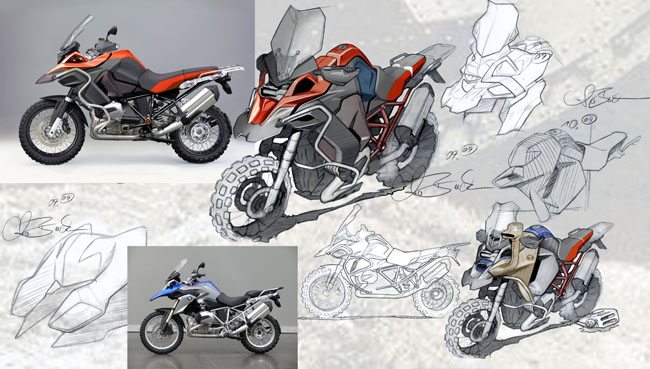
New GS “Beak” and Windscreen
The GS beak, with its more angular contours (as well as a visually separate beak extension), continues to radiate a sense of utmost resilience and supremacy.
The extension has the additional effect of further improving spray protection.
The tapered windshield — likewise purpose-developed for the Adventure — works in unison with two air flaps at the sides to improve the bike’s aerodynamic qualities as well.
The windshield features convenient, single-handed adjustment by means of a hand wheel and directs the airflow past the rider with little turbulence on fast legs of the journey, effectively reducing the strain on the upper body at high speeds in particular.
The additional flaps, meanwhile, help to reduce draught effects in the kidney area.
Ergonomics
Despite the large fuel tank, the R 1200 GS Adventure has a slim waist in the knee grip area, which does more than just add to the bike’s visual sense of lightness.
Apart from offering a wide thigh support, the seat has been made narrower at the front, giving the rider far more freedom of movement than on the predecessor model.
It is adjustable for tilt and offers seat heights of 890 and 910 millimeters as standard.
Wider enduro footrests than on the R 1200 GS together with adjustable foot-operated levers for the footbrake and gearshift make allowance for the occasional change in requirements on the new Adventure, particularly when riding off road.
It can be adapted to suit individual riding styles and habits as well as varying types of footwear.
Colors
The new 2014 R 1200 GS Adventure clearly signals its adventurous, globetrotting nature with a choice of new color schemes.
In Olive matte, the R 1200 GS Adventure draws attention to its long-distance touring qualities and exudes a particularly robust and husky air.
The BMW Motorrad brand color Alpine white lends the R 1200 GS Adventure a light look and underlines its off-road expertise.
Racing blue metallic matte, on the other hand, gives the R 1200 GS Adventure a thoroughly sporty appearance and accentuates its dynamic on-road performance abilities.
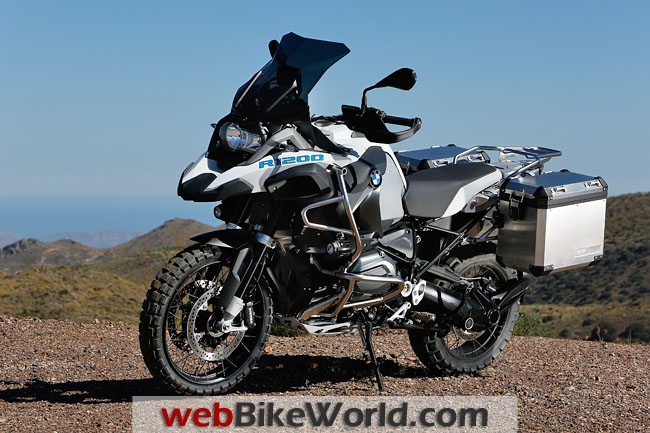
Options and Accessories
BMW Motorrad offers its customary extensive range of optional equipment and special accessories for further personalization of the new R 1200 GS Adventure.
Optional extras are integrated into the production process and supplied ex-works. Special accessories are retrofit items that can be added by BMW Motorrad dealers or customers themselves.
Pricing
As of the date of publication, 2014 BMW R 1200 GS pricing for the U.S.A. has not been announced. The list price of the new BMW R 1200 GS Adventure in Germany is €15,900.00 which includes the 19% VAT.
2014 BMW R 1200 GS Adventure Optional Equipment
- Riding mode Pro: Three additional riding modes include Dynamic, Enduro and Enduro Pro, plus the Enduro ABS and Enduro ASC add-ons for off-road riding.
- Semi-active suspension Dynamic ESA (Electronic Suspension Adjustment).
- Navigation system preparation.
- Onboard computer Pro.
- Cruise control.
- Full-LED headlight with integrated daytime running light.
- LED daytime running light.
- LED auxiliary headlights.
- LED indicators.
- Tire pressure control.
- Heated handlebar grips.
- Chrome-plated exhaust system.
- Engine map adjustment for regular fuel (RON 91).
- Anti-theft alarm system.
- Off-road tires.
2014 BMW R 1200 GS Adventure Special Accessories
- LED auxiliary headlights.
- Anti-theft alarm system.
- Aluminum cases.
- Inner bags for aluminum cases.
- Aluminum top case.
- Inner bag for aluminum topcase.
- Waterproof tank bag.
- Softbag 2 small and/or Softbag 2 large.
- LED indicators.
- HP sport silencer by Akrapovič.
- Rally seat with luggage plate (seat height 895 mm).
- Tinted windshield.
- BMW Motorrad Navigator V and holder, cable and attachment kit.
- Onboard toolkit service kit.
2014 BMW R 1200 GS Adventure Specifications
2014 BMW R 1200 GS Adventure Horsepower and Torque Curves
Key Technical Differences Between the R1200GS and R1200GS Adventure
- Tank capacity: 30 liters (GSA); 20 liters (GS).
- Spring travel front / rear: 210 / 220 mm (GSA); 190 / 200 mm (GS).
- Seat height: 890 / 910 mm (GSA); 850 / 870 mm (GS).
- Weight with tank 90% full: 260 kg (GSA); 238 kg (GS).
- Max. load: 220 kg (GSA); 212 kg (GS).
- Dimensions L / W: 2,255 / 980 mm (GSA): 2,207 / 953 mm (GS).
- Fuel consumption at 90/120 km/h: 4.3 / 5.9 liters (GSA); 4.1 / 5.5 liters (GS).
- Fuel Consumption at 55/75 MPH: 65.7 / 47.9 MPG (GSA); 68.9 / 51.4 MPG (GS).
More: 2013 BMW R 1200 GS | 2014 BMW Motorcycles | wBW BMW Motorcycles Page
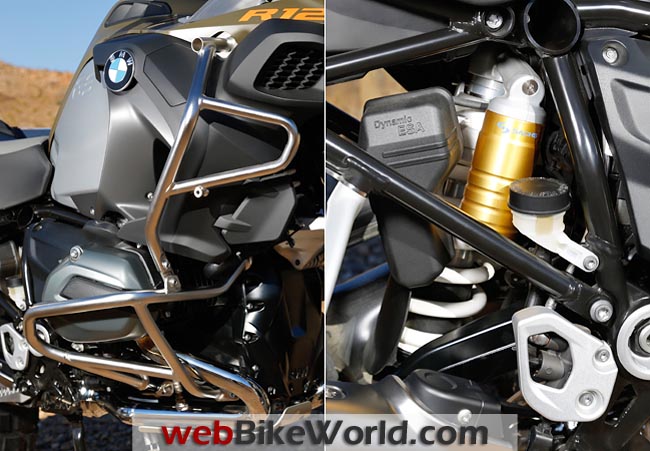
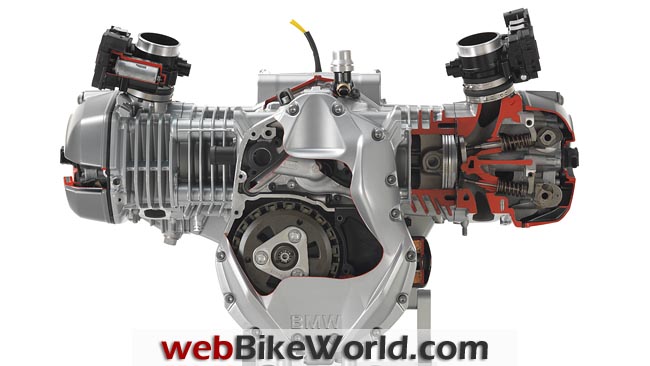
Owner Comments and Feedback
See details on submitting comments.


